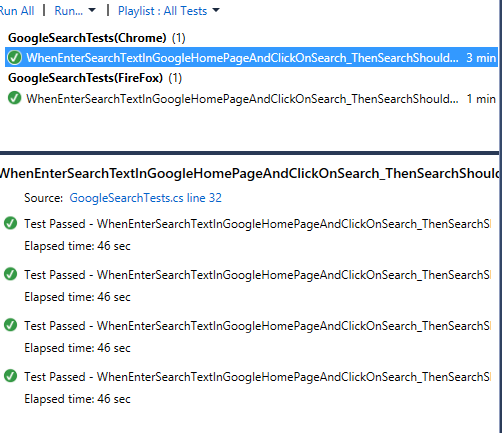Now since we have created the basic framework and page classes. Lets look at NUnit framework to create tests.
NUnit 3.0 supports parallel testing, and prior to that it supports the testing multiple iterations with different parameters.
Here if you see TestFixture attribute allows the test class to take the constructor parameter. I.E parameters you are defining in the testfixture will be passed to constructor of the test class if matching definition is found. This is very useful when we need to execute same tests with different browsers, we can define BrowserType to achieve the same purpose. The test class will be initiated and tests will be executed for each of those test fixtures.
Also Prallalizable (ParllelScope.Self) will run the test methods in parallel. More information can be found in below link. Nunit documentation
If you look at the below code, constructor of the test class has browsertype as parameter which is matching with the parameter defined the test fixture. So the test class will run for each browser type.

And the SetUp attribute is similar to TestSetup in MSTest framework or BeforeTest in TestNG. This will sets up the preconditions for each test.
If you look at the test execution flow
- Starts at calling DriverFactory.InitDriver(browserType)
- This will invoke and create corresponding BrowserDriver class object
- Driver property will be set in the DriverFactory Class with the type of the driver
- Using the DriverFactory.GetDriver() method we are getting driver to the thread which has initiated it.
- It will be passed to the Page Classes to do the rest of the test flow.

If you look at the test explorer it identifies the tests based on the TestFixture types.

When you click on run it will run all tests in parallel. You can see the results in the test explorer for each iteration Results

This is the simplest explanation I could give quickly for the Selenium with C# implementation with interface design pattern.
I have not touched any Reporting/Logging part for the framework.
As It can be implemented with ILogger interface with different logging methods so that each logging type (Excel logging, Text, Word/pdf, html) can be implemented easily.
Having said this, it will conclude our discussion on creating the framework.
Please feel free to follow and write to me if you need help in understanding any of these items.

[…] Design Selenium Framework with C# – Part 5 […]
LikeLike
Thank you for the such wonderful stuff
LikeLike
Thank you for your time for reading.. hope it helped you..
LikeLike
thanks for sharing blog on selenium framework it is really very informative keep posting
LikeLike
Thank you.. hope it helped you..
LikeLike